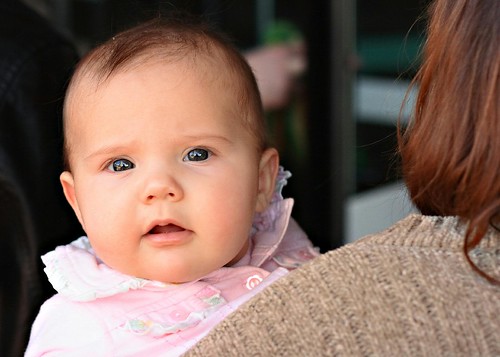
The world is a busy place, and there is much for an infant to learn. The typical infant, when carried around town by her parent, when she is not asleep is fixating curiously and intently on the world around her.
Of course, there are a lot of things in the world that are relevant and worth knowing about, and many which are probably not worth paying too much attention to. Since the baby has so much learn, it would be ideal if children had some mechanism for knowing what they should learn and what they can safely ignore.
The Pedagogical Learning Stance
Gergely Csibra and Gyorgy Gergely have argued that specific social cues are used by caregivers to direct infants to those things most worth learning about. They refer to this as a form of "pedagogy," but my sense is that they don't mean something much like formal education -- these cues can be exchanged without the adult necessarily being aware of them.
Their theory has drawn more attention to the ways in which adults and infants communicate, and what they communicate about. In a recent paper published in Science Magazine, Csibra, Gergely and colleagues suggest that they have found a partial solution to an old riddle in human development.
Perseveration
Perserverance -- sticking to your goals -- is often an admirable quality. Perseveration -- fixating on the same thing long after it ceases to be relevant or useful -- is not.
Babies are known to perseverate. In one particularly classic experiment, Piaget found a strange perseveration in infant behavior. The experiment is easy to replicate at home and works like this:
Put a ball in a bucket such that the infant cannot see into the bucket. Let the infant retrieve the ball from the bucket. Repeat this several times.
Now, in full view of the child, put the ball in a different bucket. Despite the fact that the infant just saw the ball go into the second bucket -- and despite the fact that infants are very good at tracking hidden objects and remembering where they are (contrary to earlier believe, infants ahve no problems with basic object permanence) -- they will typically look for the ball in the first bucket (81% of the time in the current study).
Are babies just stupid?
This failure on the part of the infants to carry out this simple task has often been described as a failure of inhibition. The babies remember that a particular action (searching in the first bucket) has typically led to a positive reward (a ball to play with). Even though they have information suggesting that this won't work this time around, they have difficulty inhibiting what is now an almost instinctual behavior.
What the new study shows is that a fair portion of this is due to the way the experimenter behaves during the experiment. If the experimenter actively engages the baby's attention during the task, the babies show the typical effect of continuing to search in Bucket 1 even when they saw the ball go into Bucket 2.
However, if the experimenter does not directly engage the baby (looking off to the side, not speaking to the baby, etc.), the baby actually does much better (fewer than 50% look in the wrong bucket, down from about 80%). The authors argue that this shows the perseveration effect can't be due to simply motor priming.
They suggest, instead, that by socially interacting with the baby, the experimenter is suggesting to the baby that there is something to be learned here: namely, that a ball can always be found in Bucket 1. When the experimenter does not socially engage the baby, the baby has no reason to make that inference.
Limitations
One might suggest that the babies in the non-social condition were less likely to perseverate because they were less interested in the game and just didn't learn the connection between the ball and Bucket 1 as well.
This is to some extent what the authors are also suggesting. It's important to point out that if the perseveration were caused by priming, attention does not appear to be particularly important to the phenomenon of priming in that you can be primed by something you aren't even aware of (subliminal priming). Still, one could imagine some other mechanism beyond infants believing the adult in the social condition wanted them to learn an association between the ball and Bucket 1.
Also, it is important to note that even in the non-social condition, nearly half of the infants perseverated anyway.
-------
J. Topal, G. Gergely, A. Miklosi, A. Erdohegyi, G. Csibra (2008). Infants' Perseverative Search Errors Are Induced by Pragmatic Misinterpretation Science, 321 (5897), 1831-1834 DOI: 10.1126/science.1161437
















